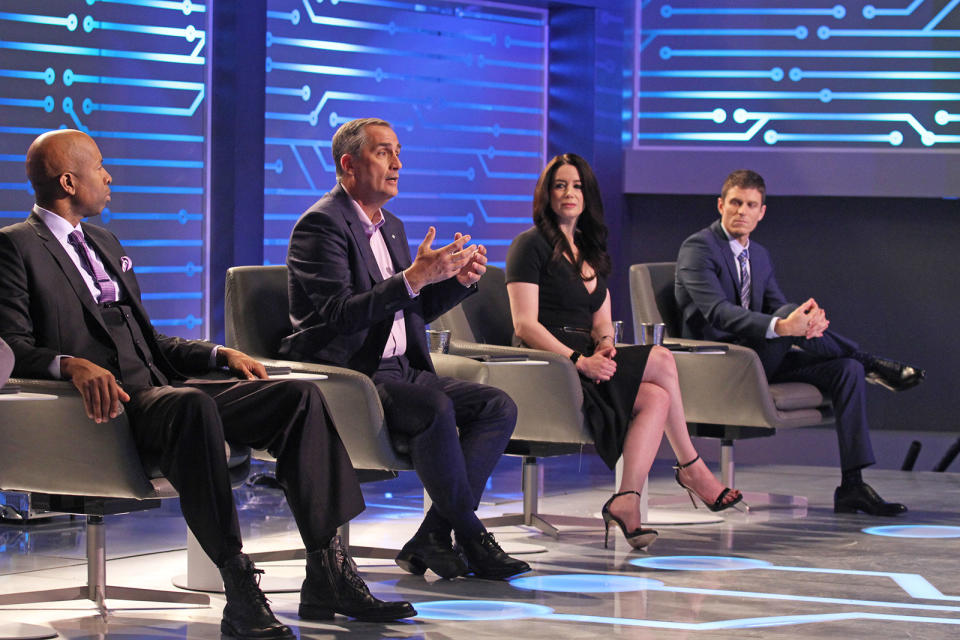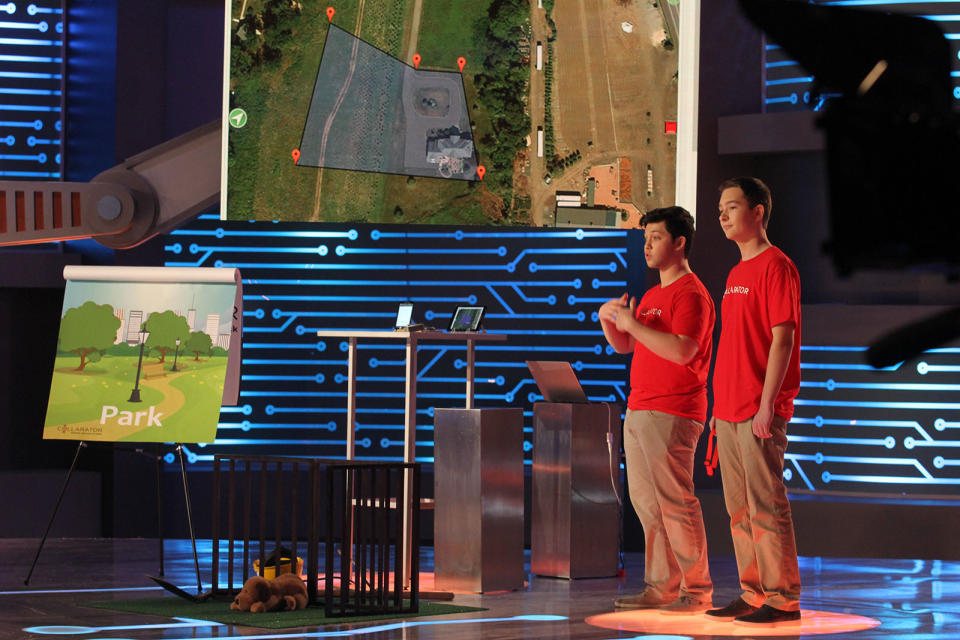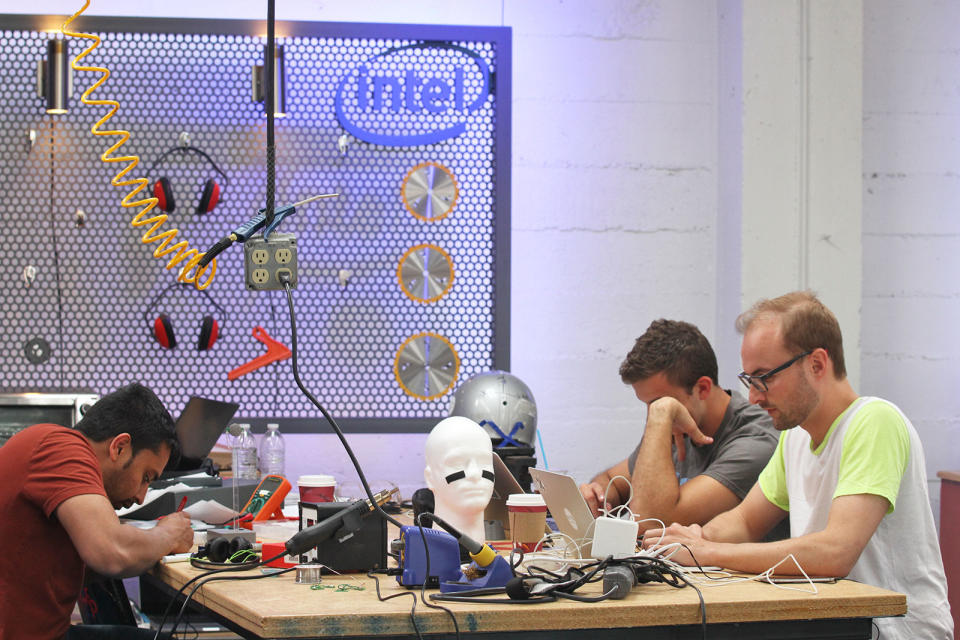The internet of ratings: How makers became hip enough for reality TV
In 'America's Greatest Makers,' 24 teams of inventors compete for a $1 million prize with one condition: Their projects must be built on Intel's technology.

Technology wasn't always hip, and neither was Intel. The company, known for most of its 48-year history as the leader in PC chips, has in recent years branched out into more cutting-edge areas. That includes mobile, drones, robots and an assortment of wearables running the gamut from a high-tech paintball helmet to an augmented-reality hard hat.
Now, in a sign of the times, Intel is joining forces with Mark Burnett, the man behind Survivor, Celebrity Apprentice and The Voice, to bring you a reality show about inventors. America's Greatest Makers, which premieres April 5th on TBS, follows 24 teams competing for a $1 million prize. Though the show follows a format similar to other reality contests, complete with auditions (pitches), guest judges and elimination rounds, the panelists are generally friendlier. Think: the NBA's Kenny Smith and celebrity dealmaker Carol Roth, not a Simon Cowell or Gordon Ramsay.
As for the projects themselves, the entries are as diverse as a Bluetooth toothbrush and smart dog collar, and some are further along in the development process. The one thing they have in common: They all use Intel's Curie module, a button-size computer whose smallness allows it to fit inside various wearables and household objects. If it wasn't already clear, Intel is betting big on the Internet of Things, and is hoping its Curie chips are one day as ubiquitous as its computer processors already are. We caught up with Intel CEO Brian Krzanich, also one the show's judges, to talk about how tinkerers finally found their way to the mainstream, and why smart objects are the next big thing.
This interview has been edited and condensed.
When I started out as a journalist 10 years ago, tech was a niche coverage area, catering mainly to nerds. Today we have a reality show about makers. How did we get here?
That's a deep question. You could separate that out into two parts. One is: Why are more people comfortable with technology and interested in technology today than before? Then, secondly, why the TV show? As things get smarter and smaller and battery life gets longer and the technology becomes more complete, they become more user-friendly.
I believe that there's a next generation of this same virtuous circle: This technology is becoming so small and so easy to use, and the battery lives are becoming so good, that a product like Curie in the hands of almost anybody can start to create things that everyday people will want to use. That's why when we introduced Curie, we introduced it at CES 2015, and I literally just pulled the button off my suit coat and said, "Here it is." It was inside my suit button the whole time. It had been measuring my steps and doing some simple things. It was really to exemplify that this is going to put computing, something that was in a personal-computer-level of computing 10 years ago, in a button on your jacket.
This TV show, then, is to show that there's all these technologies coming together -- 3D printing and the Curie module -- that allow everyday people to solve their problems with technology. You don't have to be a research-lab person anymore. You don't have to be a Ph.D. scientist. You just have to have a desire to go solve a problem, and go get access to the technology.
That was really the inception of the show and why we wanted to do it. We went and got TBS and Mark Burnett and sat them down and showed them all of this. They got really excited as well and said, "Oh my gosh, we see what you see and where things are headed and how the breakthroughs have occurred. This could be really interesting."

Team Collarator pitch their idea to the judges on the opening episode of America's Greatest Makers.
The show combines the suspense of any other reality show with themes about entrepreneurship and tech. Tell me more about that meeting of minds and how the show came to be.
I'll tell you -- what happened was Mark Burnett. It was easy for me to sit and explain to somebody what the technology could do, what was going on in the maker community, that there were these people out there already making these inventions every day. If you go to a maker fair, it's an exciting, innovative space with all kinds of people making these things. My marketing manager knew Mark Burnett and said, "That's the person you want. You explain that passion to him and that vision. If he gets it, he'll figure out how to do exactly what you described."
He'll figure out how to define what the TV show looks like, what's the culture of the TV show that we're going to create. I've got to give credit to Mark Burnett. Once he got the vision of what was occurring in this community and this ecosystem, he's the one who said, "I know how to build a TV show, and I'll get you the right panelists and build the team around this."
Mark brings this phenomenal team, his depth of knowledge of television and really just the creative genius that allows me to say, "OK, I'll tell you what, Mark. I'm going to trust you 100 percent there. Trust that I'll bring all the technology and engineering to this. Together, this will work."

Team Grush receives mentoring during TechCamp from Intel's James Jackson.
In addition to Mark's experience, you as a viewer probably had spent years watching reality television. What did you want to do differently from other competitions on the air?
I will admit that I do probably watch more reality TV than I care to. One of my favorite shows is Shark Tank. People love that show. I think what we wanted to do was have it be not as win/lose as Shark Tank. In Shark Tank, it's pass/fail right at the start. We wanted to see the progression of these teams. We want to see people take their products and move them along and allow people to see the engineering that gets done. As you go and look at the follow-on shows, you'll see some of the teams make phenomenal progress in a week's time. I was impressed with the level of engineering some of the teams were able to do in just a week.
We wanted a show that showed that progression, that allowed people to grow as they went through the season. I think that was, again, Mark's genius, that people would see that and become endeared with some of those teams: rooting for them to continue to grow their product and to continue to develop. That was a real big part of what we wanted. We wanted it to have an entrepreneurial aspect to it, so we really tried to connect these teams up, give them coaching about not only the technology side, but: How were they thinking about the audience they were trying to approach? Who were their customers? What problem were they trying to solve? Did they have that clear? Did they understand how much people would be willing to pay to solve that, and how much this was costing them to build?
All of that we wanted to draw out so that people saw how you make a product. Some people wouldn't in a couple of cases. That was OK, but we didn't ever want it to be a big negative if they didn't succeed at the end.
I was thinking as I watched the pilot that a lot of time must have gone into screening contestants. It's not like American Idol where someone could just show up and start singing.
Yeah. We had well over a thousand applications that came in. There wasn't an existing TV show and we didn't run ads or anything. We simply did it at CES and a couple of other tech forums where we knew people would be watching. Then we had a group from Turner and MGM to help us vet them. Could they be on TV and have good behavior on there? [They] vetted them to make sure they were sound people, and then a group of engineers actually looked at their capabilities and just the technical viability of their invention. Could this be built with today's technology?
We vetted those down in that methodology, down to the 24 teams that you saw. None of the judges that are on the show, including myself, got to be a part of that vetting process. What you see there, that judging and that first-time experience and observation, is real.
So the surprise that we're seeing on your faces is real.
Yes. None of us saw those devices prior to those people literally walking out there.
How did that feel?
I'll be honest with you. I'm a detail engineer at heart, so it was hard for me to hand over to my team and say, "Sure, go ahead. You make the decisions on what to do," because I love to see this technology. I love to see what people are inventing. It was hard for me to do. It was fun, though. In the end, I actually told [my colleague], who works for me and has been the lead on all of this, that that was the best decision we made because it truly allowed me to just experience it at the same time and same moment as Kenny and Carol. You got both my emotional response [and] also my technical response. You got both responses of my left brain and right brain at the same time, which I thought was much better.

Carol Roth and Kevin Pereira put Herddogg through its paces.
I'm curious as to how your own background as a maker ties into the show.
I have 34 years as an engineer here at Intel. Almost all but about the last, I don't know, four or five has been mainly on the manufacturing side, all of our silicon manufacturing. Which, in many ways, makes you a maker because you're producing a million chips a day. When I look at a 3D printer, I look at it as not only what can I build with it, but I understand exactly how that machine works. I could take it apart and put it back together. My interest in making is as much about what other technologies are coming to make it easy for makers to do things as it is the making itself.
I have my own [3D printer] at home. I have my own CNC machine for milling and making parts. I enjoy the software and how that machine works probably even more than whatever I make with it. My wife wanted a bunch of cabinets so I made a bunch of cabinets at home using the CNC machine. It was, "How does the machine work? How do I program this into the software?" All of that. Then I made the cabinets and I was like, "That was kind of fun, but what could I do to modify this machine?"
What do you think are the biggest steps required in bringing a product to market, and was it important that the contestants be in more or less the same place?
No. If you take a look at where they were when they submitted the thousand applications, from what I was told, we got everything from people who just came on screen and talked about what they wanted to build, to people who had drawings of what they wanted to build, to people who had maybe 3D printed versions but it didn't function, all the way to people who had semifunctioning systems.
We built a whole program then that once it got taken down to the 24 [teams], we assigned an engineer to each of the teams and they got access to people at UC Berkeley to help with the business side and to think about customers and what's their target audience. What kind of bill of materials price can they afford against a sales price target. Then we gave them access to an area called Tech Shop, which gave them access to all of the tools that they would need, from CNC machines to 3D printers to people who understood how to build circuit boards and things like that.

Team NWTN finessing its idea at TechCamp.
So it's really about the viability and the ingenuity and less about proven track record.
Yes. We would never do the work for them. If somebody said, "I want to make a robot that can open a door," we go, "OK. Here's the things you need to think about and bring us back your design and we'll tell you what's good and bad about your design. As you start to build it, you run into problems, let us know what the problems are." We'll give suggestions, but we always made them do the engineering and the actual work.
Intel seems to be making more of an effort lately to be a part of pop culture, like its collaboration with Lady Gaga at the Grammys. What does this approach mean for the company?
When I sit in front of my board and explain why are we doing this, it's not marketing. It's that there's a revolution going on with the way computing is getting into all of our lives. What you are seeing is us trying to show people that we can basically put a computer into just about everything you do in your life. As a result, we can add value, we can add experience to that event.
Whether it's something like the Grammys and we use digital technology to put David Bowie's face on Lady Gaga and build a robotic piano, it's showing people that computing is infiltrating that space. We did the X Games in Aspen, where we put the same module that we gave all of the makers for America's Greatest Makers.
What we wanted to show people is that basically computers are going to go into your snowboards over the next year or two. You're going to be able to go out onto the slopes and know how fast you were going and how many feet you went. If you like to go into the half pipe and do tricks, you can compare and share it with your friends. You can compare it against professionals. People will probably build a software coach that actually gives you suggestions. You should have gone a little faster, you should rotate a little bit more to help you get better at your tricks. All that's coming. As we go out and do these things, it's not just a marketing ploy. It's showing people that these experiences are going to change, and that this computing is going to go in there and that it makes it a more enjoyable and fulfilling experience.
Other than ratings, is there anything else that would make you feel that the show was a success?
Mark will probably be the one who looks at the numbers of viewers and be more analytical about was it good or bad. For me, it'll be more: Is the response from the audience that they saw how products get made, that they saw that you can do really amazing technologies now using the available technologies to the average person? If the response from people is, "Wow, this is something I could do, too," and if the response from the people who do it is, "This is a good representation of how we do it," then for me, I'll be very satisfied.
[All photos: Tommy Baynard]
